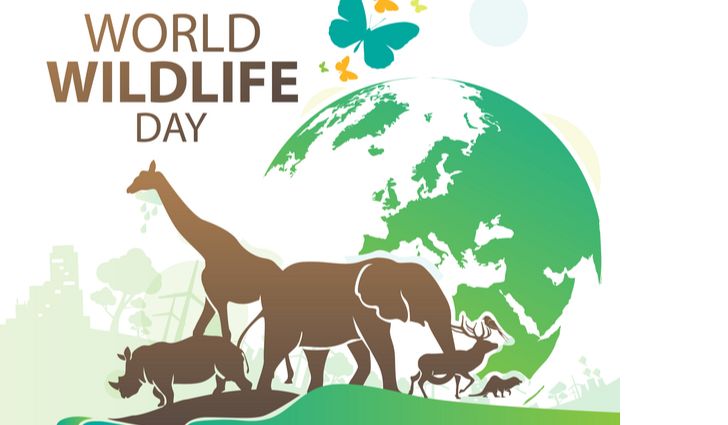“We don’t own the planet Earth, we belong to it. And we must share with our wildlife”
Every year 3rd March is observed as World Wildlife Day to celebrate the many beautiful and diverse species of wild fauna and flora and to increase awareness of the many benefits that people derive from their survival.
During 68th session of the United Nations General Assembly (UNGA) held on 20 December 2013 and agreed to declare 3rd March as World Wildlife Day proposed by Thailand, under the resolution UN 68/205 as the International Day of adoption of the Convention on International Trade on Species of Endangered Fauna and Flora (CITES) on the Planet.
Wildlife is an integral part of World Biological Diversity, and Wildlife Day is an opportunity to celebrate special places of Wild plants and animals in our ecosystem. At the same time, Wildlife Day reminds us that the battle against wildlife crime and the human destruction of biodiversity with increasing cultural, social and economic impacts needs to be stepped up. In the last 25 years, the world has lost a forested area of the size of South Africa.
World Wildlife Day 2024 Theme
This year, the theme of World Wildlife Day 2024 is “Connecting People and Planet: Exploring Digital Innovation in Wildlife Conservation.”
The theme “Connecting People and Planet: Exploring Digital Innovation in Wildlife Conservation” is about connecting people with the natural world and inspiring continued learning and action for animals and plants beyond the day.
Future of life on Earth depends on maintaining current alliances and forming new ones. WWD ought to provide inspiration and a course of action. To survive, we must alter our connection to the natural world. The biodiversity that supports a healthy world, healthy ecosystems, and healthy wildlife populations are all essential to the health of our species as a whole. This will require a coordinated effort by organizations working together, and World Wildlife Day 2023’s theme of Partnerships for Wildlife Conservation will specifically focus on this.
With the goal of bringing about change and fostering sustainability, partnerships can function on a large scale or only involve a small bunch of children or a school. To various people, it will mean different things, and each of those meanings is legitimate. To increase awareness of endangered species, some people might organize a school sale to earn money for a conservation organization. For others, it might involve publishing photos online or creating artwork. It might involve promoting the IGO collaborations that are already enlisting thousands of people in the pursuit of universal objectives.
World Wildlife Day (WWD) falls on CITES’ 50th Anniversary in the future year. For the past 50 years, CITES has been centered on partnerships, with Parties to the Convention cooperating toward the common objective of maintaining the sustainability of endangered species. The campaign for conservation, the sustainable use of wildlife, and the fight against illegal trade and the extinction of wildlife has mobilized UN agencies, businesses, philanthropies, and non-governmental groups. In order to concentrate on the protection of species and ecosystems, partnerships are crucial at the national and local levels in every nation on the planet. In order for these alliances to come together and significantly advance sustainability, wildlife conservation, and biodiversity preservation, WWD will commemorate CITES as the key intermediary.

Logo of world wildlife day
Current Challenges of Wildlife Conservation
1.According to ecologists of the University of Sydney, approximately half a billion mammals, birds, and reptiles have been killing since bushfires began in September. The number is probably significantly higher. These are Australia’s worst wildfires in decades. The deadly bushfires have devastated millions of hectares of national parks and forests, threatening wildlife and plant populations across the country. Now forest fires are became a major challenge for wildlife and bio-diversity as forest fires annually kill 6-14 million hectares of fire-sensitive forests worldwide.
2. Climate change creates new challenges for wildlife, which are worsened by reckless development and past abuses. The Africa continent is the worst hit by the water crisis and drought situation in many areas due to excessive deforestation. Lack of food and drinking water, habitat destruction, wildlife migration and wetland loss can devastate wildlife populations.
3. Due to low budget on conservation activities of wildlife , Many agencies are struggling to continue their mission.
4. The conflict between humans and wildlife is now becoming a major problem, due to the growing human population in the wildlife area it’s leading to conflict between humans and animals. Those conflicts kill more animals than poaching, according to research. Population growth leading to agriculture and infrastructure development in areas close to wildlife causing the reduction of natural habitat for the animals.
5. Illegal trade in wildlife is harming wild animal and plant populations, and pushing endangered species towards extinction. Due to its rarity and increased economic value, endangered animals and plants are often the targets of wildlife crime.
The illegal trade of animals parts– from rhino horns and elephant ivory to pangoline scales, live parrots, lion’s teeth, shark fines, medicinal plants and timber – poses an immediate global environmental problem that has gradually increased in the past few decades.Trafficking of wildlife is a multifaceted global threat that erodes biodiversity and ecological integrity, leading to massive organized trafficking criminalizing local communities for limited returns.
To address wildlife trafficking and poaching challenges, stronger policy structures, agencies, and law enforcement are required.
Amazing facts about animals as given by National Geographic
Bengal tiger – The roar of a tiger can be heard as far as two miles away.
Cheetah– The only big cats who can’t roar are Cheetahs.
Giant Panda– A giant spent half the day in eating.
Giraffe– Giraffe’s heart weight is about 25 pounds.
Red Fox– fox can use its tail to communicate with other foxes.
Polar Bear – Polar bears have black skin under their white flur.
Wolf– The wolves can go without eating for more than a week.
Swikriti Dandotia












